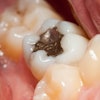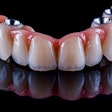
With xerostomia comes a need for a saliva substitute. But given the options available, which ones are best suited to the specific needs of each patient? Now, a new in vitro study has found that some saliva substitutes can contribute to dental erosion. The data can help dentists create treatment plans using the right kind saliva substitute for the right patient.
The clinical significance of their results, published in the Journal of Dentistry, is straightforward and can be implemented in practice: "It can be recommended that patients suffering from xerostomia and at high risk for dental erosion should use high-viscous saliva substitutes, but should avoid saliva substitutes with low pH or containing citric acid," the authors wrote (June 2014, Vol. 42:6, pp. 720-725). The contributing researchers are from the dental departments at the University of Zurich in Switzerland; the University of Ege in Turkey; and the University of Göttingen in Germany.
“Avoid saliva substitutes with low pH or containing citric acid.”
They took a systematic approach to their investigation, which included 12 spray and three gel saliva substitutes, to find out if these substitutes played a role in enamel erosion, and compared their effects to that of a mouth rinse that was recently shown to have antierosive properties, SnCl2/AmF/NaF. Some products had clear advantages over others.
The researchers prepared 204 bovine enamel specimens for their study, examining them with a stereomicroscope to ensure that they were free of cracks on the surface, and placing them randomly into 17 groups of 12 specimens each. The researchers tested 12 mouth sprays and three gels, and used water spray as a negative control, while a mouth rinse with SnCl2/AmF/NaF was used as a positive control.
They used an artificial mouth to create six erosive daily attacks in a de-/remineralization cycle that mimicked real-life conditions of someone consuming a typically erosive beverage.
The samples were rinsed with the tested material for one hour, eroded with citric acid for 30 seconds, and then rinsed with the material for 15 seconds. Lastly, to complete one cycle, the artificial mouth chamber was opened, and the researchers applied the saliva substitute, gel or spray, or control material, and closed it. Then the next cycle started.
After the cycles were completed, the researchers measured the enamel loss and compared it to the baseline profile.
| Comparison of enamel loss | ||
| Tested materials by brand name | Enamel loss (µm) | pH |
| Mouth sprays | ||
| Aldiamed (Certmedica International) | 1.53 ± 0.54 | 5.91 |
| Biotene (GlaxoSmithKline) | 1.75 ± 0.61 | 6.18 |
| Emofluor (Dr. Wild) | 0.46 ± 0.21 | 7.42 |
| EvoDry (Evolife Laboratories) | 1.65 ± 0.47 | 7.18 |
| Glandosane (Helvepharm) | 0.83 ± 0.46 | 5.03 |
| Mouth Kote (Parnell Pharmaceuticals) | 8.61 ± 2.98 | 3.12 |
| Oasis (Oasis Consumer Healthcare) | 0.36 ± 0.31 | 6.28 |
| Rain Spry (Xlear) | 1.98 ± 0.97 | 6.87 |
| Saliva natura (Medac) | 6.35 ± 1.03 | 5.09 |
| Saseem Mundspray (G. Pohl-Boskamp) | 0.54 ± 0.40 | 5.11 |
| Stoppers 4 (Jocott Brands) | 4.56 ± 1.00 | 3.61 |
| Thayers (Henry Thayer Company) | 4.24 ± 1.26 | 6.49 |
| Gels | ||
| Biotene oralbalance (GlaxoSmithKline) | 1.04 ± 0.68 | 5.49 |
| GC Dry Mouth Gel (GC) | 1.68 ± 0.80 | 7.38 |
| Orajel (Church & Dwight) | 2.15 ± 0.61 | 6.27 |
| Control groups | ||
| Erosion Protection (GABA) | 1.25 ± 0.51 | 4.17 |
| Water | 3.82 ± 1.37 | 0.85 ± 0.07 |
The researchers noted several interesting findings. "It was shown that the application of four mouth sprays even increased the erosive loss, while six products significantly decreased erosive enamel loss to the range of the positive control," the researchers explained. "These products might be recommended for patients with dry mouth in terms of prevention of enamel erosion."
The researchers noted "significantly increased" enamel loss in some products in the spray category, likely due to their low pH (pH < 4, Mouth Kote, Stoppers 4), or the fact that they contained citric acid (Saliva natura, Thayers). "Previous studies found a remineralizing effect of Saliva natura on artificial carious lesions, but in these studies the calcium and phosphate content was increased compared to the native product," they acknowledged.
Overall, the researchers warned clinicians of the erosive potential for products containing citric acid or low-pH products. These products "exhibit a distinct erosive potential, while most high-viscous products present an erosion-protective effect, probably due to their film-forming properties," they concluded.















